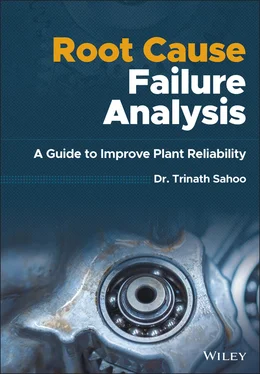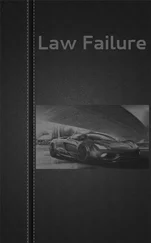Trinath Sahoo - Root Cause Failure Analysis
Здесь есть возможность читать онлайн «Trinath Sahoo - Root Cause Failure Analysis» — ознакомительный отрывок электронной книги совершенно бесплатно, а после прочтения отрывка купить полную версию. В некоторых случаях можно слушать аудио, скачать через торрент в формате fb2 и присутствует краткое содержание. Жанр: unrecognised, на английском языке. Описание произведения, (предисловие) а так же отзывы посетителей доступны на портале библиотеки ЛибКат.
- Название:Root Cause Failure Analysis
- Автор:
- Жанр:
- Год:неизвестен
- ISBN:нет данных
- Рейтинг книги:5 / 5. Голосов: 1
-
Избранное:Добавить в избранное
- Отзывы:
-
Ваша оценка:
- 100
- 1
- 2
- 3
- 4
- 5
Root Cause Failure Analysis: краткое содержание, описание и аннотация
Предлагаем к чтению аннотацию, описание, краткое содержание или предисловие (зависит от того, что написал сам автор книги «Root Cause Failure Analysis»). Если вы не нашли необходимую информацию о книге — напишите в комментариях, мы постараемся отыскать её.
Provides the knowledge and failure analysis skills necessary for preventing and investigating process equipment failures Root Cause Failure Analysis: A Guide to Improve Plant Reliability
Root Cause Failure Analysis: A Guide to Improve Plant Reliability
Root Cause Failure Analysis — читать онлайн ознакомительный отрывок
Ниже представлен текст книги, разбитый по страницам. Система сохранения места последней прочитанной страницы, позволяет с удобством читать онлайн бесплатно книгу «Root Cause Failure Analysis», без необходимости каждый раз заново искать на чём Вы остановились. Поставьте закладку, и сможете в любой момент перейти на страницу, на которой закончили чтение.
Интервал:
Закладка:
Testing
First and foremost, a test protocol must be developed and agreed to by all parties. The protocol is usually separated into non‐destructive and destructive evaluation. Destructive evaluation, in the forensic sense, includes any process that alters the evidence. Testing also includes cleaning and some types of “non‐destructive” testing. Significant care must be taken prior to any destructive testing. Again, details of all testing, destructive and non‐destructive must be shared and agreed to by all involved parties.
Non‐Destructive Evaluation/Non‐Destructive Testing (NDE/NDT)
Depending on the metal alloy, various types of non‐destructive inspection can be performed. Non‐destructive inspection can reveal discontinuities or additional cracking in the component. The most common types of NDE/NDT are Liquid Penetrant Testing (PT), Fluorescent Penetrant Inspection (FPI), Magnetic Particle Inspection (MPI), Acoustic Emission Testing (AE), Radiographic Testing (RT), and Ultrasonic Testing (UT). All these tests are used to detect surface cracks and discontinuities. Radiography is used mainly for internal examination. A photographic record of the results of non‐destructive inspection is a necessary part of record keeping in the investigation.
Mechanical Testing
Mechanical testing determines properties of a material when force is applied, therefore indicating its appropriate use in mechanical applications. The mechanical properties of metals can be expressed in numerous ways: strength, ductility, hardness, toughness, etc. The hardness and the strength of a material are closely related. Hardness is useful for estimating wear resistance and approximate strength; and is defined as the resistance of a material to surface indentation. Rockwell hardness is the most widely used method for determining hardness and several different Rockwell scales are utilized for materials of a variety of hardness ranges. Aluminum alloys, brass, and soft steels are often measured on the Rockwell B scale or HRB, whereas harder steels and titanium are measured on a Rockwell C scale or HRC. Other ways to obtain mechanical properties include tensile testing, compression testing, impact testing, fatigue testing, and fracture toughness testing, etc., depending on the application and performance requirements of the component.
Macroscopic Examination
Macroscopic examination is an extension of the visual examination and evaluates quality and homogeneity of the part. It is used to determine the origin of the failure and the type of fracture such as ductile, brittle, torsion or fatigue. Microstructural features can be used to assess internal quality, presence of hydrogen flakes, chemical segregation, hard cases, flow lines, and welds. A stereomicroscope (1–50×) is often utilized for the macroscopic examination. It is during this step that the fracture surface is evaluated. The first piece of information often observed is where the fracture initiated, that is, locating the fracture “origin” or “origins” and determining whether it/they are located at the surface or below the surface. It is also important to note the fracture direction in relation to the normal or expected loading. Markings on the fracture surface formed during the initiation and propagation of the crack can be used to evaluate the fracture and determine origin of cracking. Examination of the origin by the experienced failure analyst may reveal the cause and determine any contributing factors toward failure.
Microscopic Examination
Microscopic examination is usually performed in a Scanning Electron Microscope or SEM. A Scanning Electron Microscope is a high‐power magnifying and imaging instrument that uses an accelerated electron beam as a light source. The SEM allows magnifications up to 50 000× and improves depth‐of‐field resolution. A Metallurgical Expert can examine the fracture surface in the SEM and determine fracture topography while inspecting the origin area for anomalies. It is in the SEM that the Metallurgist can classify the fracture and determine the fracture type. Semi‐quantitative chemical information can also be gathered while in the SEM by Energy Dispersive X‐Ray Analysis.
Metallographic Examination
Metallography is defined as the science of the constitution and structure (or microstructure) of a metal. During metallographic inspection, the failure analyst or technician, sections the area of interest usually through abrasive‐wheel cutting and mounts the specimen without deformation. The metallographic cross section is then polished to a mirror‐like finish. The sample is subsequently examined by the Metallurgist in a metallurgical microscope.
Many important macroscopic properties of metallic materials are highly sensitive to the microstructure. Critical mechanical properties, like tensile strength or elongation, as well as other thermal or electrical properties, are directly related to the microstructure.
Metallographic examination involves the use of high magnification microscopy. These examinations may include optical and scanning electron microscopy. Optical microscopic examination is used to determine grain size, microstructure, and inclusion type and content. On the other hand, scanning electron microscopy is used to determine abnormalities, such as inclusions, segregation, and surface layers, as well as fracture features.
Chemical Analysis
A chemical analysis is sometimes performed by the Metallurgical Expert to determine bulk chemistry, local elemental concentration, surface corrosion products, and coating chemistry. A failed component chemically analyzed to determine whether the grade is indeed as claimed, because mixes occasionally occur at the mill, in the warehouse, or at the fabrication or manufacturing shop. A small percentage of all failures are caused by grade mixes. Chemical analysis can verify conformance to a standard or specification, detect impurities, identify alloys, and analyze trace elements. Analytical chemistry can be performed by a variety of techniques including optical emission spectroscopy, atomic emission spectroscopy, and inductively coupled plasma analysis, to name a few.
Simulations
Occasionally, the investigator must simulate the environmental conditions encountered during service to ascertain suitability of the material to environmental conditions and to determine the effect of prior heat treatment or other processing on the service performance of the material. For example, improper heat treatment may render the material susceptible to certain types of attack. Simulation of the heat treatment as reported in the case history is valuable for both confirmation purposes and for further testing, particularly on a comparison basis (e.g., comparison of the toughness of the failed material as received and after various experimental heat treatments). Certain types of simulation tests require accelerated testing to obtain the desired information in a reasonable length of time. Interpretation of accelerated test data must be done with care.
Data Analysis, Conclusions and Report
After the completion of the outlined steps, the investigator should be ready to interpret and summarize the data that has been collected. Some of the work performed may not contribute in determining the root cause of the failure, yet it may be helpful in eliminating some possible causes. In combination, the steps that have been outlined will, in most cases, enable the investigator to conclude the root cause of the failure. The report should provide the following:
Description of the failed component
Conditions at the time of failure
Читать дальшеИнтервал:
Закладка:
Похожие книги на «Root Cause Failure Analysis»
Представляем Вашему вниманию похожие книги на «Root Cause Failure Analysis» списком для выбора. Мы отобрали схожую по названию и смыслу литературу в надежде предоставить читателям больше вариантов отыскать новые, интересные, ещё непрочитанные произведения.
Обсуждение, отзывы о книге «Root Cause Failure Analysis» и просто собственные мнения читателей. Оставьте ваши комментарии, напишите, что Вы думаете о произведении, его смысле или главных героях. Укажите что конкретно понравилось, а что нет, и почему Вы так считаете.












